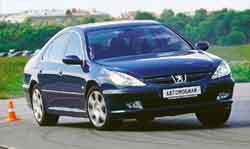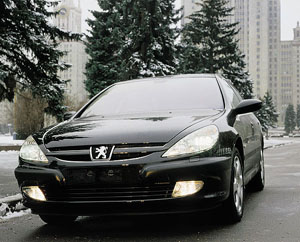PEUGEOT Test drive 607 2000 - 2005 sedan
Leo is preparing to jump
When forming a package of orders on the Peugeot 607, it turned out that the diesel version of the HDI and gasoline with the Porsche Tiptronic System is caused by increased interest. And then what is in demand was combined in one modification.PEUGEOT 607 buyers are wealthy people. And most thicknesses, as you know, are obsessed with saving. Before parting with money, they carefully calculate the profitability of the next acquisition, weigh all the pros and cons and are often made by conservative habits in favor of the achievements of modern technologies. This explains the demand for the technique equipped with the latest, but relatively inexpensive 607th Peugeot model. In particular, for the HDI turbodiesel version with the Automatic Transmission of Porsche Tiptronic System.
Like all 607th, this novelty of PEUGEOT is stuffed with all kinds of goodies: ABS, an anti-boom system, cruise and climate control, chic music, electric systems with memory. There are more fresh innovations: a stabilization system in space, shock absorbers adjustable in stiffness, an assistant brake force, rain sensors, air pressure sensors, folding side mirrors.
HDI with a machine gun-the same Grand Hotel number on wheels, but reconstructed, better equipped and standing 15-20% less than competitors-Mercedes-Benz E-class, BMW 5th series, Volvo S80, Audi A6. The generosity of the French is largely explained by the use of the latest multiplex wiring, which significantly reduced electronic amenities. However, a lot has already been said about this.
But the merger of a diesel engine with an automatic transmission, working to reduce operational costs, is very interesting. And although 607 HDI is not a record holder in the saving fuel, 6.8 liters of diesel fuel required by a 100 km machine are presented, regarding the appetites of gasoline versions, and continuous benefits.
The modest HDI needs for fuel are not achieved by dynamic indicators. The Peugeot turbodiesel flagship has quite decent acceleration and maximum speed. A one and a half -ton limousine gains 100 km/h in 12 with a small second and can cover two hundred kilometers in an hour. Its 4-cylinder 16-valve engine with direct injection is not a charming low-speed of the 60s! Nowadays, the boundaries between diesel and gasoline engines have practically erased. So a hundred percent sense of fullness is provided by everyone who has been standing behind the wheel of Peugeot 607 HDI.
If you do not attach importance to the characteristic chattering of the engine operating on idle, you can’t catch the difference between the HDI and the gasoline version - neither in the response of the machine to supply gas, nor in terms of vibration and noise in the cabin (actually absent). The power of the 2.2 -liter diesel engine is 136 hp at 4000 min-1. You will receive a torque at 317 nm at 2000 min-1, with 250 nm the engine gives out for 1200 min-1.
HDI has all the advantages of the unit equipped with a smart fuel direct injection system - Common Rail. The engine has an aluminum alloy head with two upper distributions. A pair of independent ducts is suitable for each cylinder in it. One swirls an air flow for better mixing of air with fuel injected into the combustion chamber, the other enhances the flow rate and its rotation, connecting to work, when the number of revolutions of the motor exceeds a certain level. The system controlled by the processor optimizes the vortex formation of air masses in the inlet phase, due to which the best power parameters are achieved.
The HDI diesel is equipped with a supercharged geometry, which effectively regulates the pressure depending on the engine speed. The speed set occurs smoothly, in one breath, without pickups and downs.
The motor is equipped with a filter for capturing residual combustion products, delaying the entire micromurus and burning it at a temperature of 450 C during a repeated additional injection carried out by Common Rail.
The acoustic and vibrational comfort of the Peugeot 607 HDI owes in many ways to two balancing motor shafts and a preliminary injection system, which provides a soft combustion of a working mixture without a noise peak that does not have Common Rail.
The advantages of a turbodiesel are supplemented by the abilities of a self -adaptive automatic gearbox with a manual mode. AKP Porsche Tiptronic System significantly increases the flexibility of the transmission. The box adjusts to the road environment and driving manner, choosing one of 32 possible algorithms. The terrain, the steepness of the turns of the road, the clutch of the wheels with the surface, as well as the tension of the traffic flow (in the city) and emergency situations that are recognized by the frequency and power of pressure on the accelerator are taken into account.
Having trained the box, we achieved more liveliness in the behavior of the car. True, the effect was not as significant as it was assumed, but most likely it happened because the 607th from the very beginning readily reacted to the gas increase.
The machine, in addition to sports and winter programs, has a manual switching mode. The driver is given freedom of choice. Judging by the high k.p. Tandem gearbox - engine (dialogue between them is conducted using multiplex communication), there is no doubt about the advisability of their joint use. From this interaction, Peugeot 607, of course, won.
The completion of the chassis carried out by PEUGEOT specialists after the first tests of the 607th was reduced to a change in the characteristics of shock absorbers and wheel installation angles, an increase in the stiffness of the silent blocks of the front and the support supports of the back, as well as the use of wider and lowest rubber. This turned out to be enough to shift (but not abolish) the threshold of loose exchange rate stability with a straightforward movement into the area of \u200b\u200bhigher speeds and practically eradicate the tendency of the machine to drift.
On the highway, at a speed of up to 170 km/h, the flagship, as if claws clings to the surface of the road and only during further dispersal detects light transverse discretion. However, this circumstance is not significant in control, even when moving at maximum speed.
We sincerely checked the tenacious of the car in vihiles on an extensive deserted platform. On real (about 60-80 km/h) speeds of the 607th, under the deafening screech of tires with some signs of insufficient rotation, she bit in turn, stubbornly not wanting to wag the stern. Perhaps by increasing the pace, the car would have been able to win, but why? In the end, this is not a sports car.
So, Peugeot 607 continues to improve. Big Leo is preparing to jump. Its sales (first gasoline versions, then HDI) will begin in the fall.
Technical characteristics of Peugeot 607 HDI
Equipped mass, kg - 1550
Dimensions (length/width/height), mm - 4871/1835/1460
Base, mm - 2800
Maximum speed, km/h - 202
Acceleration time from 0 to 100 km/h, s - 12.1
Control consumption of fuel, l/100 km (mixed cycle) - 7.2
Engine:
- Type- diesel, 4-cylinder., 16-valve., with direct injection of sommon rail
- working volume, cm3 - 2179
- Power, L.S. at min -1 - 136/4000
- torque, NM at min -1 - 317/2000
Transmission - automatic, with manual mode
Text: Igor Kuznetsov
A source: Magazine 5 wheel [08/2000]
Video Crash tests Peugeot 607 2000 - 2005
PEUGEOT 607 2000 test drives - 2005
PEUGEOT 607 2000 - 2005
Krassh Test: Detailed Information26%
Driver and passengers
3%
Pedestrians











